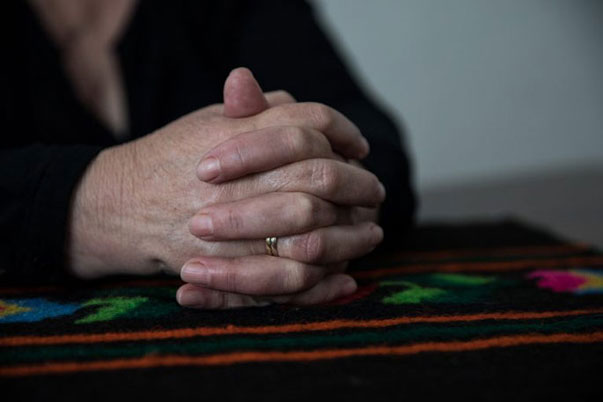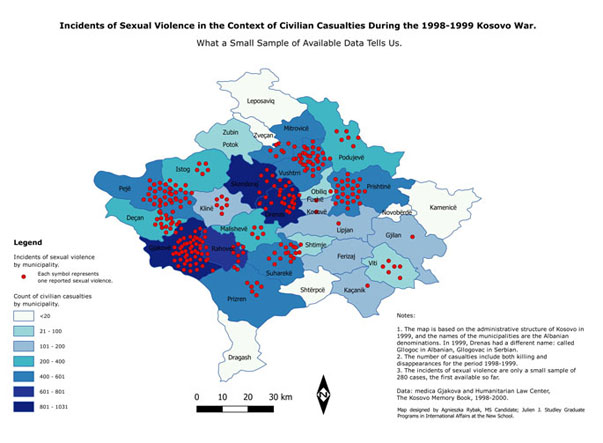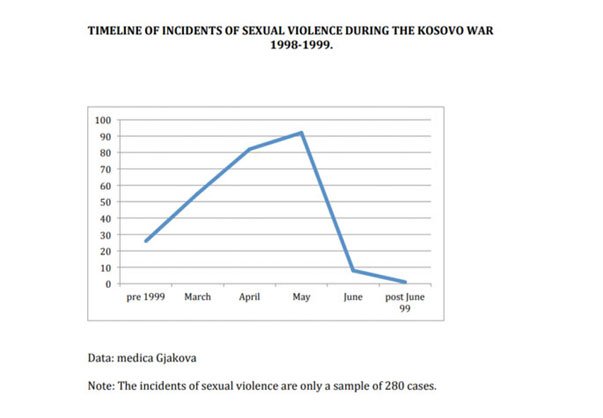|
Wartime
sexual violence: new evidence as
hundreds of survivors come forward
By Anna Di Lellio, Mirlinda Sada and
Garentina Kraja | 22 November 2018

A wartime
survivor from Drenas. | Photo:
Valerie Plesch.
Following a trail
of fresh evidence from wartime
sexual violence survivors in Kosovo,
researchers connect the dots and
reveal the true pattern of sexual
violence as a weapon of war and
ethnic cleansing across the country.
The first time the
crime of wartime sexual violence was
given the label of “tool of war” was
during the conflict in Bosnia and
Herzegovina. Though targeting all
ethnic groups, Serbian security
forces used sexual violence
systematically against Bosnian women
as part of their strategy of ethnic
cleansing.
Nearly 20 years
after the Kosovo war of 1998-1999,
survivors come forward and identify
the date, the place and the
circumstances surrounding instances
of sexual assault. We can prove that
sexual violence was used as a tool
of war in Kosovo as well. It was
never just a practice, a “bad thing”
tolerated by commanders as the war
raged on.
At the
International Criminal Tribunal for
Yugoslavia in The Hague, ICTY,
sexual violence in Bosnia and
Herzegovina featured prominently in
the conviction of senior military
figures. The trials of Serbian
military and security leaders
indicted for war crimes and crimes
against humanity in Kosovo had
different outcomes in regard to the
count of sexual assault: General
Nebojsa Pavkovic was convicted in
the first instance, but Nikola
Sainovic, Sreten Lukic, and
Vlastimir Djordjevic were found not
guilty, because only a handful of
witnesses had testified.
Only on appeal, in
2014, were all of them convicted on
charges of wartime sexual violence.
The Court ruled, reversing its
previous trial judgements, that
these leaders knew, but did nothing
to stop, the widespread sexual
violence that was occurring at the
same time as destruction of
property, mass expulsions and mass
killing of Albanian civilians. In
that context, sexual violence
amounted to persecution of a group
and a crime against humanity.
We can now add new
and more damning evidence to the
Court’s conclusion.
Data collected
from 280 survivors of wartime sexual
violence perpetrated by the Serbian
Army, the police, and the unofficial
groups of perpetrators they
commanded, prove that there was a
pattern, a logic and an intent to
the use of sexual assault as a
weapon deployed systematically and
strategically along with mass
murder, the burning and the
pillaging of property, targeting
Albanian civilians.
This evidence
completely disproves the Serbian
leaders’ line of defense: that they
did not know their forces were
raping Albanian women, that rape was
never a strategy, and that if it
happened, it was just a sporadic,
opportunistic act.
The cases we
analyzed are just a small number in
comparison with the total count of
survivors, but together with the
complete data on civilian casualties
compiled by the Kosovo Humanitarian
Law Center, there is a large enough
sample to map the strategy of terror
and destruction planned by the
Milosevic regime.

The map shows
without any ambiguity that killing,
disappearances and sexual violence
in Kosovo during 1998 and 1999 were
overlapping throughout the war
against Albanian civilians. It
confirms what OSCE and Human Rights
Watch investigators had concluded as
early as 1999: sexual violence was
“a weapon of ethnic cleansing” in
Kosovo, like in Bosnia.
We looked at the
data and asked the question: what
was happening in those places at the
same time that sexual violence was
happening? Looking into the stories
of just a fraction of the survivors
interviewed, we can affirm what the
court was only ever able to imply.
The timeline: mapping sexual
violence in the Kosovo war
We noticed a
sizable number of incidents from
Beleg and Carrabreg, just south of
Decan, between March 25 and March
28, 1999. That is exactly when
Serbian troops clamped down first on
Upper and Lower Carrabreg, then on
Beleg.
All the people,
villagers coming from a larger
surrounding area who had not found
refuge in the mountains, were told
they had five minutes to leave their
homes; everyone was robbed of cash
and everything of value they
possessed; all the houses were
burned; men were stripped naked,
publicly humiliated and randomly
shot; and several women, displaced
from the larger surrounding area,
were put in a barn and raped by
multiple perpetrators.
Finally, they were
all loaded on tractors and driven to
the Albanian border. The final tally
of civilian casualties is 38, and we
now know that there are many more
survivors of sexual violence than
the two witnesses who summoned the
courage to testify in The Hague: we
counted a total of 15 in our sample
alone.
A cluster of rapes
happened in the larger area
surrounding Shtutice and Verbec
,Drenas, on April 28 and 29, 1999.
Then on the night of April 29, NATO
bombed the Feronikel factory, a
legitimate and legal military
target, since it had been used as a
base and a detention facility where
torture was practiced. The bombing
elicited an even more brutal attack
on Albanian civilians, and more
rapes. Early on April 30 Serbian
troops seized Shtutice and Verbec
and killed respectively 44 and 80
civilians. All the houses were
burned, and many more civilians were
taken prisoners and held overnight
at the mosque in Cirez.
The next day,
during the transport to prison, 102
were taken off the trucks and
executed at the Shavarina mines in
Citakove e Vjeter. Before and after
the killing, many women were
tortured: we know of 17 of them.
Incidents cluster
in significant numbers in Studime,
the prison of Smrekonice, and
Vushtrri, around May 2, 1999. On
that day, columns of displaced
people pushed by Serbian forces out
of their homes in the surrounding
area and converging on Studime, to
the east of Vushtrri, were harassed
and robbed by police and army
despite the display of a white flag.
The women were
separated from the men and a number
of them were held in a school, many
were raped, 22 in our sample, as the
men were being killed, 106 of them
in one day.
The rest of the
displaced, taken to the prison of
Smerkovice, endured from two to
three weeks of illegal detention
during which they were tortured,
denied food, and held in inhumanely
cramped quarters.

On May 22 they
began to be released daily in groups
and were marched to the border with
Albania. Some were pulled out of the
convoy and publicly sexually
assaulted at the Ramiz Sadiku
cemetery, as two survivors
testified. From June 22 through June
8, about 3,000 men who had been
detained at Smerkovice crossed the
border into Kukes. Many had their
hands broken from the beating and
knew nothing of their wives and
mothers from whom they had been
separated in Studime.
Finally, what
explains the multiple rapes in
Dragaqine, a remote village seven
kilometer north east of Suhareke?
Fighting had
stopped there by end of March, and
displaced people had gathered there,
but Serbian troops returned on April
21, 1999, killing a dozen of men and
raping several women. We counted 8
in our sample.
We looked at the
data and heard the stories of
survivor. They are all very clear
about what happened. Victims were of
all ages: at the two extremes, a
nine-year-old and a
seventy-year-old.
The majority of
these survivors were not only raped,
but also scarred with cigarette
burns and knife cuts. They were the
victims of multiple aggressors,
cursed and insulted for their ethnic
origin. They were left traumatized,
as the living embodiment of the
attempt to destroy an entire people.
Their entire experience is a
textbook definition of rape as a
weapon in a strategy of ethnic
cleansing.
Anna Di
Lellio is a Professor of
International Relations at New York
University and The New School, NY.
Garentina
Kraja is an independent researcher
working from Kosovo.
Mirlinda
Sada is the executive director of
NGO Medica Gjakova.
Feature
photo: Valerie Plesch.
|